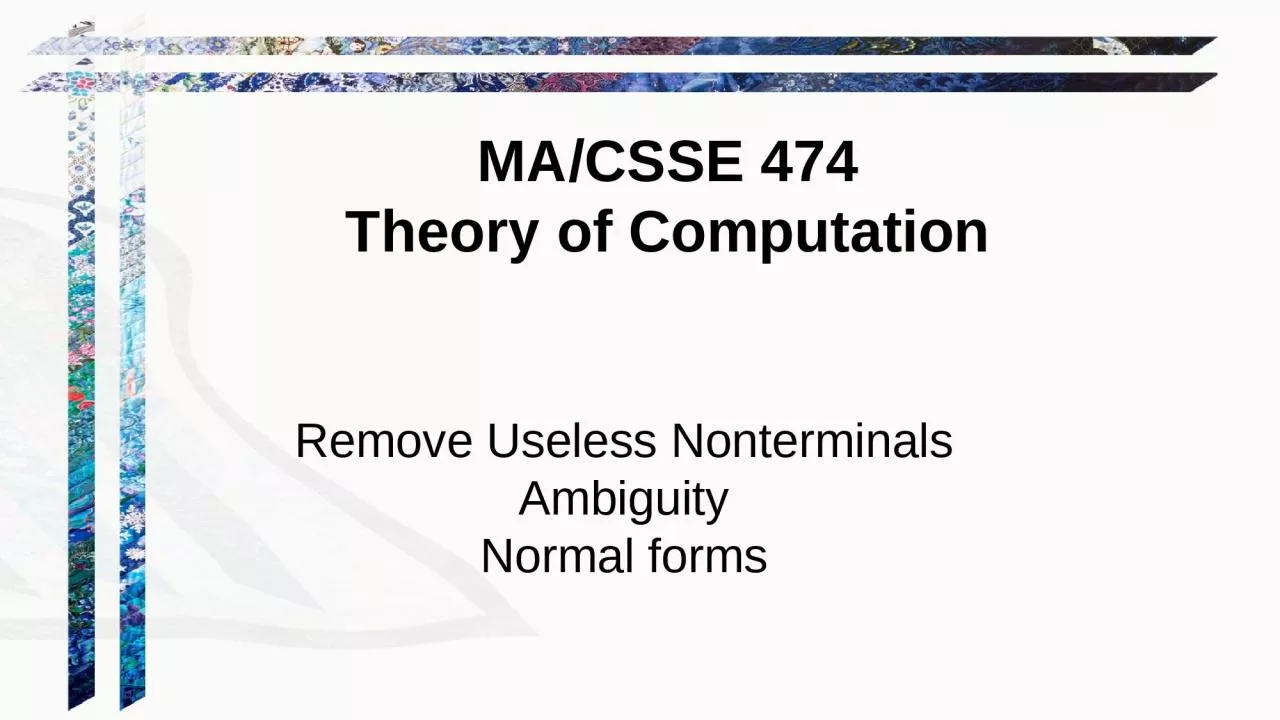

Ambiguity Normal forms MACSSE 474 Theory of Computation Your Questions Previous class days material Reading Assignments HW 9 10 problems Anything else This is quite a complement to Euclid ID: 1002367
Download Presentation The PPT/PDF document "Remove Useless Nonterminals" is the property of its rightful owner. Permission is granted to download and print the materials on this web site for personal, non-commercial use only, and to display it on your personal computer provided you do not modify the materials and that you retain all copyright notices contained in the materials. By downloading content from our website, you accept the terms of this agreement.
1. Remove Useless NonterminalsAmbiguityNormal formsMA/CSSE 474Theory of Computation
2. Your Questions?Previous class days' materialReading AssignmentsHW 9, 10 problemsAnything elseThis is quite a "complement" to Euclid!
3. Prove the Correctness of a Grammar AnBn = {anbn : n 0} G = ({S, a, b}, {a, b}, R, S), R = { S a S b S }● Prove that G generates only strings in L. ● Prove that G generates all the strings in L.
4. Simplify Context-Free Grammars Remove non-productive and unreachable non-terminals.
5. Remove Unproductive Nonterminals removeunproductive(G: CFG) = G = G. Mark every nonterminal symbol in G as unproductive.Mark every terminal symbol in G as productive.Until one entire pass has been made without any new nonterminal symbol being marked do: For each rule X in R do: If every symbol in has been marked as productive and X has not yet been marked as productive then: Mark X as productive.Remove from G every unproductive symbol.Remove from G every rule that contains an unproductive symbol. Return G.
6. Remove Unreachable Nonterminals removeunreachable(G: CFG) = G = G. Mark S as reachable.Mark every other nonterminal symbol as unreachable.Until one entire pass has been made without any new symbol being marked do: For each rule X A (where A V - ) in R do: If X has been marked as reachable and A has not, then: Mark A as reachable.Remove from G every unreachable symbol.Remove from G every rule with an unreachable symbol on the left-hand side. Return G.
7. Parse trees capture essential structure: 1 2 3 4 5 6S SS (S)S ((S))S (())S (())(S) (())()S SS (S)S ((S))S ((S))(S) (())(S) (())() 1 2 3 5 4 6S S S ( S ) ( S ) ( S ) Derivations and parse trees
8. Parse Trees A parse tree, (derivation tree) derived from a grammar G = (V, , R, S), is a rooted, ordered tree in which:● Every leaf node is labeled with an element of {}, ● The root node is labeled S, ● Every other node is labeled with an element of N = V - and● If m is a non-leaf node labeled X and the (ordered) children of m are labeled x1, x2, …, xn, then R contains the rule X x1 x2 … xn.
9. S NP VP Nominal V NP Adjs N Nominal Adj Nthe smart cat smells chocolateStructure in English
10. Generative Capacity Because parse trees matter, it makes sense, given a grammar G, to distinguish between: ● G’s weak generative capacity, defined to be the set of strings, L(G), that G generates, and ● G’s strong generative capacity, defined to be the set of parse trees that G generates.
11. Algorithms Care How We Search or Derive Algorithms for generation and recognition must be systematic. They typically use either the leftmost derivation or the rightmost derivation. S S S ( S ) ( S ) ( S )
12. Derivations of The Smart Cat A left-most derivation is: S NP VP the Nominal VP the Adjs N VP the Adj N VP the smart N VP the smart cat VP the smart cat V NP the smart cat smells NP the smart cat smells Nominal the smart cat smells N the smart cat smells chocolate A right-most derivation is: S NP VP NP V NP NP V Nominal NP V N NP V chocolate NP smells chocolate the Nominal smells chocolate the Adjs N smells chocolate the Adjs cat smells chocolate the Adj cat smells chocolate the smart cat smells chocolate
13. Ambiguity A grammar is ambiguous iff there is at least one string in L(G) for which G produces more than one parse tree*.For many applications of context-free grammars, this is a problem. Example: A programming language. If there can be two different structures for a string in the language, there can be two different meanings. Not good!* Equivalently, more than one leftmost derivation, or more than one rightmost derivation.
14. An Arithmetic Expression Grammar E E + E E E E E (E) E id
15. Inherent Ambiguity Some CF languages have the property that every grammar for them is ambiguous. We call such languages inherently ambiguous.Example:L = {anbncm: n, m 0} {anbmcm: n, m 0}.
16. Inherent Ambiguity L = {anbncm: n, m 0} {anbmcm: n, m 0}.One grammar for L has these rules:S S1 | S2 S1 S1c | A /* Generate all strings in {anbncm}.A aAb | S2 aS2 | B /* Generate all strings in {anbmcm}.B bBc | Consider any string of the form anbncn.It turns out that L is inherently ambiguous.
17. Ambiguity and undecidability Both of the following problems are undecidable*: Given a context-free grammar G, is G ambiguous? Given a context-free language L, is L inherently ambiguous?Informal definition of undecidable for the first problem:There is no algorithm (procedure that is guaranteed to always halt) that, given a grammar G, determines whether G is ambiguous.